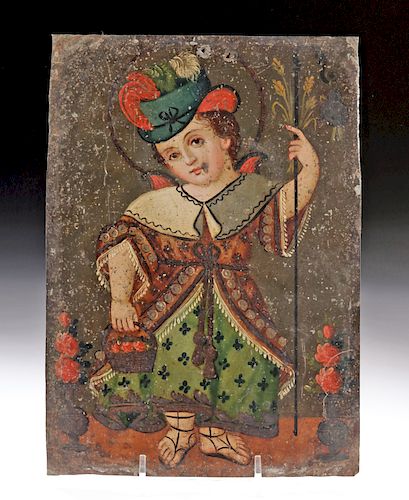19th C. Mexican Tin Retablo - El Nino de Atocha
Lot 335
About Seller
Artemis Gallery
686 S Taylor Ave, Ste 106
Louisville, CO 80027
United States
Selling antiquities, ancient and ethnographic art online since 1993, Artemis Gallery specializes in Classical Antiquities (Egyptian, Greek, Roman, Near Eastern), Asian, Pre-Columbian, African / Tribal / Oceanographic art. Our extensive inventory includes pottery, stone, metal, wood, glass and textil...Read more
Categories
Estimate:
$500 - $800
Absentee vs Live bid
Two ways to bid:
- Leave a max absentee bid and the platform will bid on your behalf up to your maximum bid during the live auction.
- Bid live during the auction and your bids will be submitted real-time to the auctioneer.
Bid Increments
| Price | Bid Increment |
|---|---|
| $0 | $25 |
| $300 | $50 |
| $1,000 | $100 |
| $2,000 | $250 |
| $5,000 | $500 |
| $10,000 | $1,000 |
| $20,000 | $2,500 |
| $50,000 | $5,000 |
| $100,000 | $10,000 |
| $200,000 | $20,000 |
About Auction
By Artemis Gallery
Jan 7, 2020
Set Reminder
2020-01-07 10:00:00
2020-01-07 10:00:00
America/New_York
Bidsquare
Bidsquare : VARIETY AUCTION - Antiquities / Ethnographic
https://www.bidsquare.com/auctions/artemis-gallery/variety-auction---antiquities-ethnographic-4787
Around the world & back in time - be amazed at the treasures you will find. Antiquities from Egypt, Greece, Italy and the Near East, Asian, Pre-Columbian, African / Tribal / Oceanic, Native American, Spanish Colonial, Russian Icons, Fine Art, much more! Artemis Gallery info@artemisgallery.com
Around the world & back in time - be amazed at the treasures you will find. Antiquities from Egypt, Greece, Italy and the Near East, Asian, Pre-Columbian, African / Tribal / Oceanic, Native American, Spanish Colonial, Russian Icons, Fine Art, much more! Artemis Gallery info@artemisgallery.com
- Lot Description
**First Time At Auction**
Latin America, Mexico, ca. 19th century CE. An antique retablo painted on heavy gauge tin and depicting El Nino de Atocha. The tradition of the child may be traced back to a suburb of Madrid, where prisoners of the faith were said to have been visited and nourished by a young boy dressed as a wandering pilgrim. Because of the miraculous nature of the child's appearance, this subject has traditionally been interpreted as a manifestation of the Child Jesus. In this retablo, he is shown in his traditional capelet and brimmed hat, with a traveler's staff in his left hand and a basket of bread in his right. El Nino de Atocha stands between two vases of roses, and the color palette and style draw from an earlier Baroque tradition. Size: 7" W x 9.875" H (17.8 cm x 25.1 cm)
El Nino de Atocha, among the most popular subjects in Mexican retablo art, is the patron saint who frees prisoners, and performs miracles for travelers as well as those in danger. Imagery of the saint originated in Spain after the Moors invaded the town of Atocha. According to legend, a prison was filled with Christians lacking fundamental necessities like food and water. Only missionary children were permitted to visit these prisoners, and one day after family members prayed intensely, a child dressed as a pilgrim and carrying a basket, a staff, and a gourd full of water appeared. He then served everyone in the prison; however, miraculously, his basket and gourd were still full. This miraculous visitation led believers to regard him as the Infant Jesus.
Provenance: private Boulder, Colorado, USA collection
All items legal to buy/sell under U.S. Statute covering cultural patrimony Code 2600, CHAPTER 14, and are guaranteed to be as described or your money back.
A Certificate of Authenticity will accompany all winning bids.
We ship worldwide and handle all shipping in-house for your convenience.
#150845Normal surface wear with expected scuffs/scratches and minor losses to pigmentation. Metal sheet is a bit wavy and has developed a nice warm patina on the unpainted verso. Two perforations at the top center presumably for attaching to the wall.Condition
- Shipping Info
-
All shipping is handled in-house for your convenience. Your invoice from Artemis Gallery will include shipping calculation instructions. If in doubt, please inquire BEFORE bidding for estimated shipping costs for individual items.
-
- Buyer's Premium



 EUR
EUR CAD
CAD AUD
AUD GBP
GBP MXN
MXN HKD
HKD CNY
CNY MYR
MYR SEK
SEK SGD
SGD CHF
CHF THB
THB













